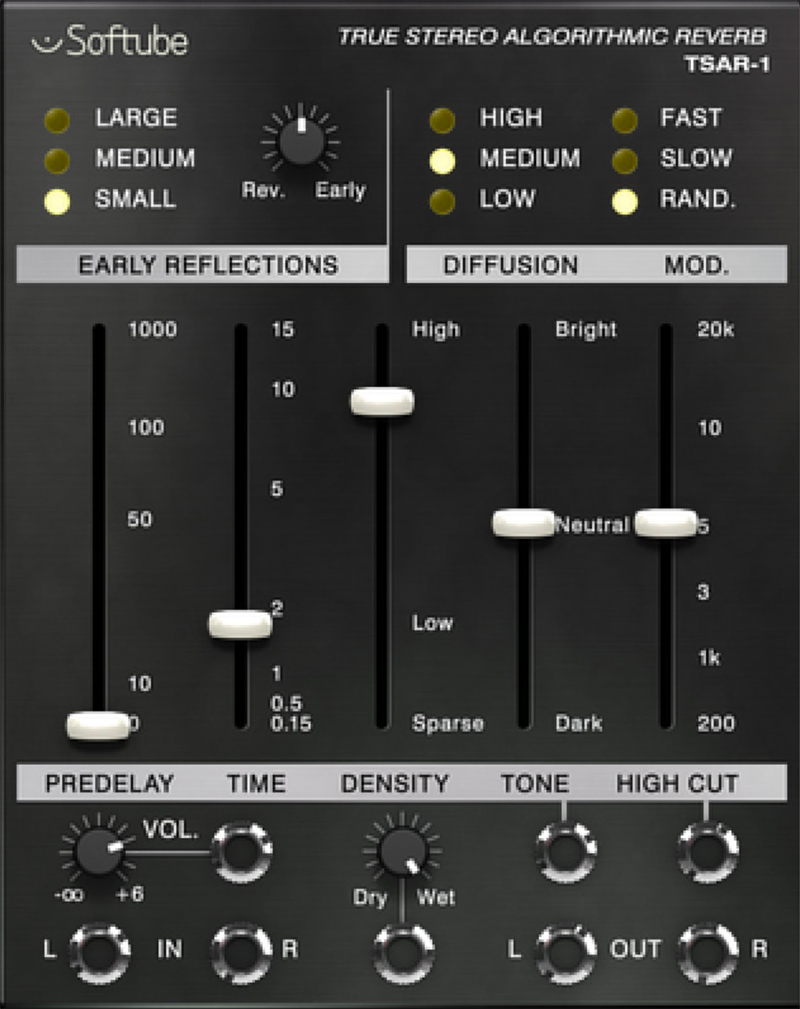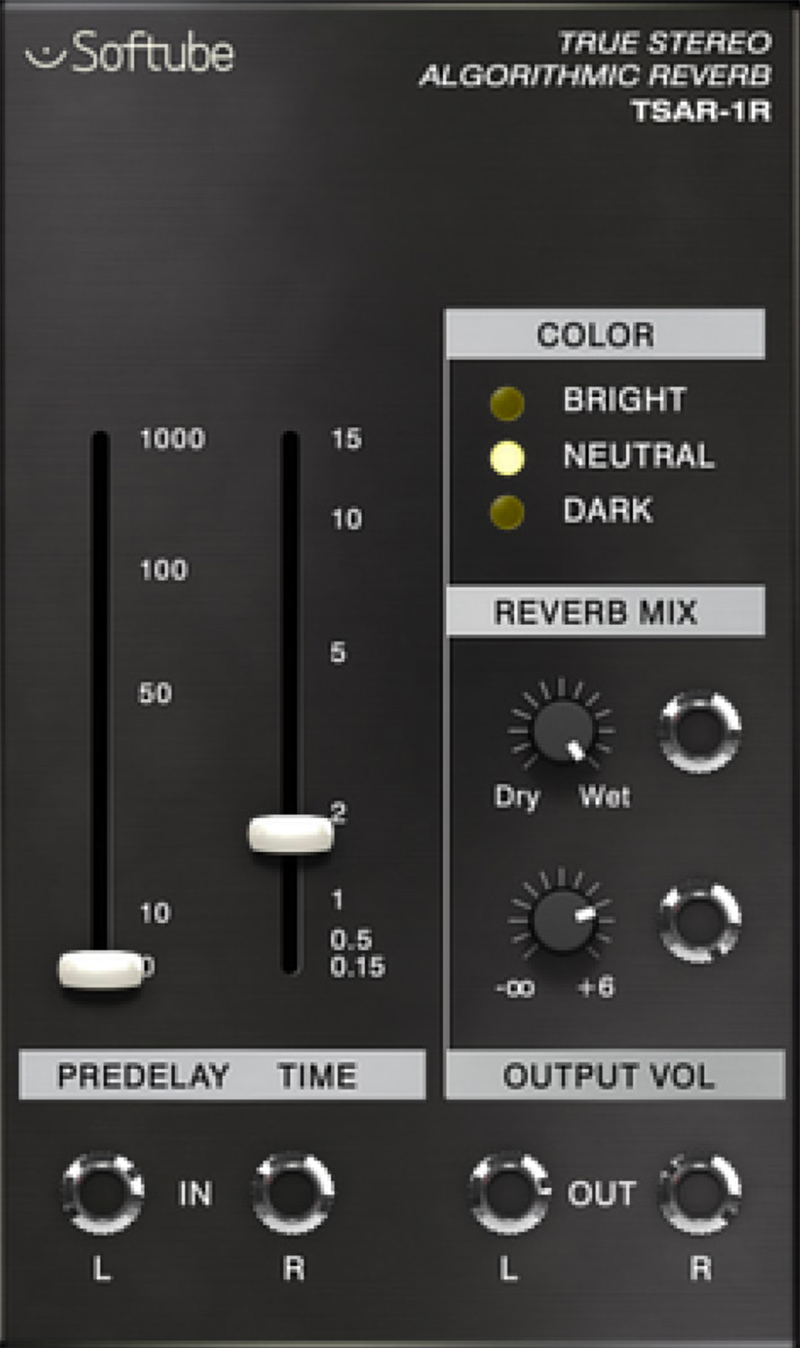User Manual
TSAR-1 and TSAR-1R Reverb for Modular
Intro
TSAR-1 User Interface
Parameters
Inputs
Outputs
TSAR-1 In Use
TSAR-1R User Interface
Parameters
Inputs
Outputs
TSAR-1R In Use
The TSAR-1 Reverb is not an emulation. It's not a stock design. It's not a snapshot of a space. The TSAR-1 is a powerful, modern reverb algorithm. It's alive and vibrant, it's gentle and dreamy, and above all – it's natural and believable. The TSAR-1 is the better-sounding alternative to the established, traditional reverb products. At a fraction of the price.
For a full description of TSAR-1 and TSAR-1R, please see its main chapter.
Both TSAR-1 and TSAR-1R are based on the same reverb algorithm, but uses different controls. TSAR-1 gives the user more power to control the details, while TSAR-1R is easy to dial in, and very easy to get a good natural sound from.

ER Type: SMALL, MEDIUM, LARGE
The Early Reflections (ER) Type give the user a sense of the room dimensions.
ER Mix: 0-100%
The Early Reflections (ER) mix parameter sets the relationship between the early reflections and reverb tail.
Diffusion: LOW, MEDIUM, HIGH
This parameter set the smoothness of the sound, but also a sound with high density also takes more space in the mix.
Modulation: RANDOM, SLOW, FAST
The modulation parameter sets modulation of the internal feedback loop. For most reverbs Random sounds most natural, but you can set it to Slow or Fast for a more chorus-y effect.
Pre-Delay: 0-1000ms
This parameter sets amount of delay between the early reflections and reverb tail.
Reverb Time: 0.15 – 15s
This knob sets the time it takes for the volume of the reverb tail to drop 60 dB. In a real world analogy, the reverb time would be how much the walls of a room reflect the sound. For instance, a big room with much acoustic treatment has shorter reverb time than a stonewall church of the same size.
Density: 0-100%
The density parameter sets whether you want a small space with thicker, smoother reverb with more reflections (high density) or a larger, thinner sounding one (low density). Low density reverbs are very handy if you need a long reverb that doesn’t take up too much energy in your mix.
Reverb Tone: -100 (Dark), through 0 (Neutral) to 100 (Bright)
This knob will adjust the tonality/ color of TSAR-1's reverb tail.
High Cut: 0.2 – 20kHz
This knob adjusts the cutoff point for the high frequencies for both the tail and early reflections.
Output Volume: -inf – 6dB
Sets the output volume of the TSAR-1 module (including dry signal).
Reverb Mix: 0-100% (dry to wet)
This knob sets offset mix between the direct signal and the reverb signal (including early reflections).
The TSAR-1 module in Modular builds on the same principles as the TSAR-1 plugin. For more detailed information on the inner workings of the TSAR-1 algorithm, look at the TSAR-1 chapter in the Softube Plug-Ins Manual.
Volume CV: This input jack let you externally control the overall output Volume of the TSAR-1 module in Modular (including the Dry signal).
Tone CV: The Tone CV input jack externally controls the tonality/color of TSAR-1 Module's reverb tail.
High Cut CV: The High Cut CV input controls the cutoff frequency of for the tail and early reflections.
In L: This is the left input jack of the TSAR-1 module, it is normalized to the right input if no cable is inserted there meaning that a mono signal easily can be spread across the whole reverb.
In R: This is the right input jack of the TSAR-1 module.
Reverb Mix CV: This CV jack is for external control of the Reverb mix. Incoming CV at this jack is added to the Reverb Mix offset set by the Reverb Mix knob.
Out L: Main output of the TSAR-1, left channel.
Out R: Main output of the TSAR-1, right channel.
Feeding TSAR-1 on to itself can be lots of fun, but it can create unpleasant feedback, be careful not to ruin your ears!
Add your TSAR-1 module anywhere in your patch where you want to insert reverb, most commonly would probably be right before patching to main output. Use the Dry/Wet knob to adjust the level of reverb in your patch. But you could of course also use the TSAR- 1 module as a completely “WET” source and mix it through an external mixer module such as the Audio mixer or X-fade mix modules.
The presets supplied in Modular and Modular FX shows some different uses of TSAR-1 in Modular.
The TSAR-1R is very easy to dial in. Just select the type of room you want (from STUDIO to LARGE HALL) and decide if you want a BRIGHT, NEUTRAL or DARK sounding reverb. That's it!
TSAR-1R Reverb is the little sibling of the more adjustable TSAR-1 Reverb. They share exactly the same high end reverb algorithm, but TSAR-1R offers extreme ease of use for a fast and intuitive workflow.

Predelay: 0-200ms
The Predelay has the same function as the TSAR-1 Module, but is limited to 200 ms maximum delay time (which is more than enough for natural sounding reverbs).
Reverb Time: 0.2 – 15s
In the TSAR-1R module the Reverb Time parameter adjusts an internal pre-delay, the early reflections, diffusion, density and decay time – all at once. All these parameters have been meticulously fine-tuned to give you a natural sounding result.
Color: DARK, NEUTRAL, BRIGHT
This parameter set the overall tonal character of the TSAR-1R module. BRIGHT is useful for strings and vocals, or when you want to give the perception of a highly reflective room, NEUTRAL for normal halls or studios, and DARK for smaller spaces with a lot of acoustic damping.
Reverb Mix: 0-100%
This knob sets offset mix between the direct signal and the reverb signal.
Output Volume: -inf – 6dB
Sets the output volume of the TSAR-1R module (including the dry signal).
Reverb Mix CV: This CV input jack is for external control of the Reverb mix. Incoming CV at this jack is added to the Reverb Mix offset set by the Reverb Mix knob.
Output Volume CV: This input jack let you externally control the overall output Volume of the TSAR-1R module (including the Dry signal).
In L: This is the left input jack of the TSAR-1R module, it is normalized to the right input if no cable is inserted there.
In R: This is the right input jack of the TSAR-1R module.
Out L: Main output of the TSAR-1R module, left channel.
Out R: Main output of the TSAR-1R module, right channel.
Feeding TSAR-1 on to itself can be lots of fun, but it can create unpleasant feedback, be careful not to ruin your ears!
Add your TSAR-1R module anywhere in your patch where you want to insert reverb, most commonly would probably be right before patching to main output. Use the Dry/Wet knob to adjust the level of reverb in your patch. But you could of course also use the TSAR- 1R module as a completely “WET” source and mix it through an external mixer module such as the Audio mixer or X-fade mix modules.
The presets supplied in Modular and Modular FX shows some different uses of TSAR-1R in Modular.